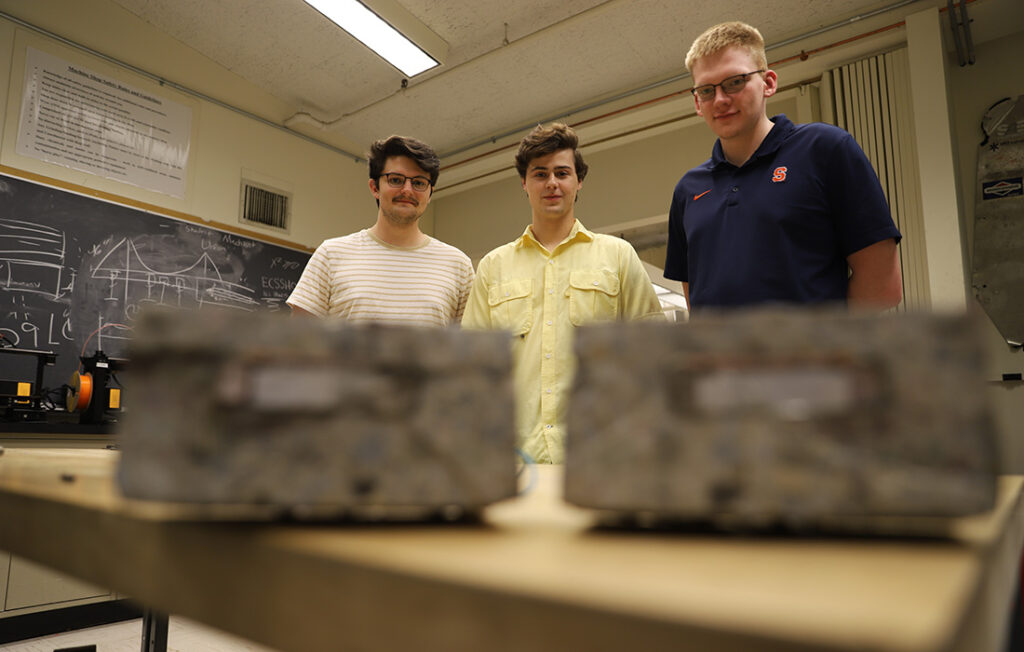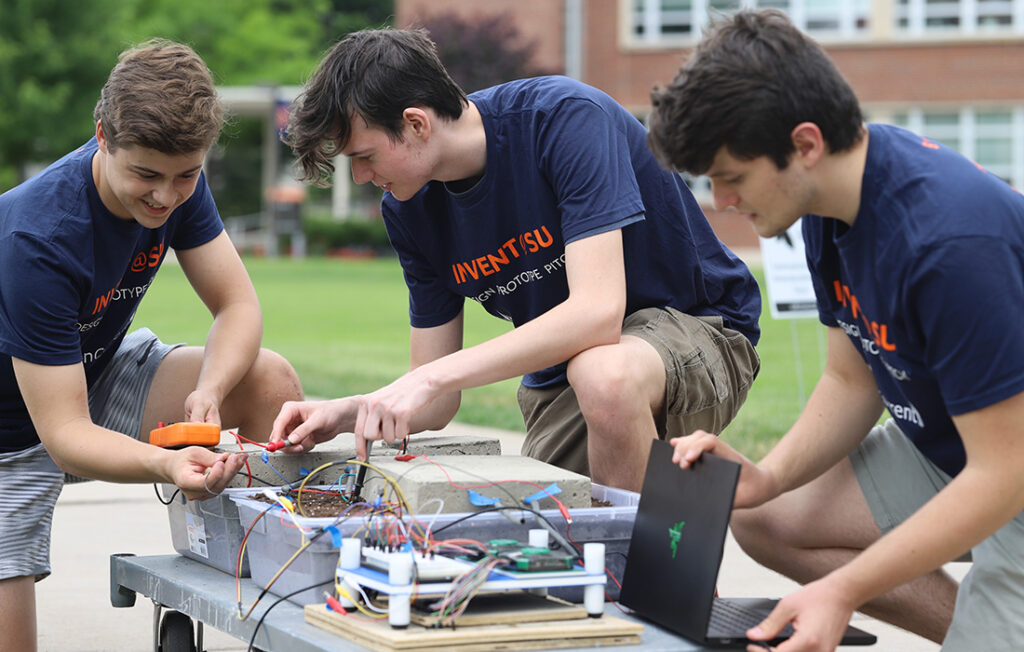
Imagine a city where streetlights and crosswalks no longer rely on electric grids for power. Instead, they draw their energy from the construction material that makes up several buildings and sidewalks: concrete. While it sounds far-fetched, three College of Engineering and Computer Science students, Ian Storrs, Brendan Murty, and Ryan Mussaw, are working to make this a reality. Through research and testing, their discoveries have the potential to be a new commercial technology that harnesses an overlooked source of energy and makes an impact on sustainability.
Their invention, ConCurrent, relies on the principles of thermodynamics, a field of physics that involves energy, temperature, and heat. Concrete on its own can’t generate electricity. But heat can – and construction materials like concrete and asphalt can soak up a large percentage of the sun’s heat. With a huge amount of heat being absorbed into the concrete, the engineering trio discovered an ingenious way to transform this wasted energy into a power source by turning heat absorbed by concrete into electricity. This began their journey into the world of renewable energy research.
Originally a pitch for Invent@SU, their prototypes were concrete blocks fused with a thermoelectric generator, which transforms heat absorbed by the block into electricity when one side of the block is hot, and the other side is cool. The temperature difference between each side is crucial to generating electricity—the greater the temperature difference, the more electricity can be generated.

“We were thinking our invention could power things in close proximity to roadways and illumination for sidewalks like embedded lights, kind of like what you’d see at movie theatres when you’re walking down the aisle,” Murty said.
However, a single concrete block isn’t enough to generate power for crosswalks or streetlights, so they’ll need a considerable number of these devices to achieve this. These blocks have been helpful in exploring the concept of heat, concrete, and electricity and they’ve included other materials in their prototypes to amplify the temperature difference on each side of the block.
“We included a copper plate on top to absorb heat and pull it down from the surface of the concrete,” Storrs said. “The aluminum plate pulls heat from the bottom to try to cool it. The sides are also wrapped in foam insulation to reduce heat escaping. And on the bottom, we have a heat pipe, a copper tube with fluid that’s good for moving heat.”
While some may think ConCurrent is solar power with extra steps, there are some differences. Solar power relies on sunlight. ConCurrent relies on solar radiation or the heat absorbed from the sun’s radiation. This means even when the sun goes down, their invention can continue functioning since concrete absorbs and retains heat.
“It’s a resource that hasn’t really been tapped in a real effective way. We have solar, which harnesses the sun’s energy but this specific realm hasn’t been focused on,” Murty said.
The research aspect of the project was by far the most interesting part to the engineers. They would be able to continue research on ConCurrent when offered a position at the Industrial Assessment Center (IAC) at the start of fall 2022. At the assessment center, Storrs, Murty, and Mussaw assisted manufacturing companies in conserving energy by suggesting changes in lighting and other power sources. Funded by the assessment center, their work also helped them when it came to research and they spent the summer reading other academic papers and building different iterations of the design.
“It’s a relatively small research area,” Storrs said. “We did find other projects that were doing similar things like a solar collector, but those projects focus on asphalt road surfaces. They’re also different since they have pipes underneath roads that circulate water and air to collect heat.”
ConCurrent’s function heavily relies on temperature difference, so the engineers have explored ways to reduce energy loss. They’ve considered filling the empty space of their thermoelectric generator with insulation materials and conducted experiments to test the effectiveness of covering pavement with absorbent black paint, as this could help increase solar radiation absorption. Their research has also allowed them to delve deeper into understanding heat absorption in asphalt pavements. Even with their many triumphs, however, the engineers did encounter some issues along the way.

“Since we’re a self-guided research team, we’ve had to narrow the scope and direction of our project as we did our literature review,” Storrs said. “This was initially overwhelming, but we were able to meet with the engineering librarian Jaun Denzer who was enormously helpful in pointing us in the right direction.”
Despite being a self-guided group belonging to different programs within ECS, the engineering trio is far from a ragtag bunch – they’re a dream team. Whether it be Storrs’s mechanical engineering knowledge or Murty’s previous experience using modeling software in his aerospace engineering course, each member has contributed something noteworthy to the project to make it what it is today.
Mussaw, who joined the group after Invent@SU, and his electrical engineering expertise also came in handy for ConCurrent’s electrical components, something the group initially struggled with during the competition. He discussed some things he desired to achieve with this invention.
“We’re hoping to have multiple temperature sensors throughout the prototypes we’re using,” he explained. “We’re also hoping to pull weather data from Syracuse Airport so we can compare weather data from stations – there will be a lot of data analysis to paint a better picture of what’s going on.”
Matthew Brewster, a civil engineering student who exited the group after Invent@SU, was credited with designing how their invention would look and even suggested using thermoelectric generators while ConCurrent was in its early stages of development.
“One of the ideas I had initially suggested when brainstorming was developing some type of solar sidewalk where the solar cells could be laid out and pressed into wet concrete,” Storrs said. “Matthew suggested using thermo-electric generators, which I had never heard of before. We essentially just ran with it from then on.”
What began as an Invent@SU pitch has now evolved into a research project where every member, current and former, has contributed to the project’s success. And though they didn’t place in the competition, their collective drive to make a positive impact on the environment has led to the creation of innovative solutions for renewable energy. With support from the ECS faculty and their experience at the assessment center, these engineers are paving the way for clean energy solutions and revolutionizing the way we consume power.
